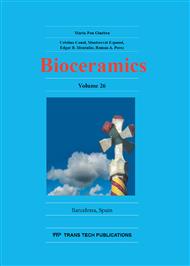p.156
p.160
p.166
p.173
p.179
p.184
p.193
p.198
p.202
Dissolution Behavior of Zinc from Gel Composites Consisting of Calcium Phosphate and Alginate
Abstract:
Amorphous calcium phosphate (ACP) is known as one of the precursors of bone hydroxyapatite (HAp). The ACP transforms into low crystalline HAp around 40°C. Zinc (Zn) is an essential trace element for the human body and has an important role in bone formation. Osteoporosis has been linked to Zn deficiency. Biomaterials that release Zn at site of bone resorption can potentially inhibit the progression of osteoporosis. In this study, we successfully prepared Zn-releasing injectable materials that consisting of ACP and alginate gel. We investigated the Zn dissolution behavior from these composite samples in environment that imitate bone metabolism. The Zn containing gel released Zn into an acetic acid buffer, which mimics the environment of osteoclast activity. In contrast, the gel sample did not released Zn when soaked in a simulated body fluid (Kokubo’s solution), a solution that mimics the environment of osteoblast activity and cell quiescence. Therefore, the ACP/alginate gel composite that is cross-linked with Zn2+ could control the rate of release in Zn. These gels are expected to be a Zn controlled-release intelligent material.
Info:
Periodical:
Pages:
179-183
Citation:
Online since:
November 2014
Authors:
Price:
Сopyright:
© 2015 Trans Tech Publications Ltd. All Rights Reserved
Share:
Citation:


